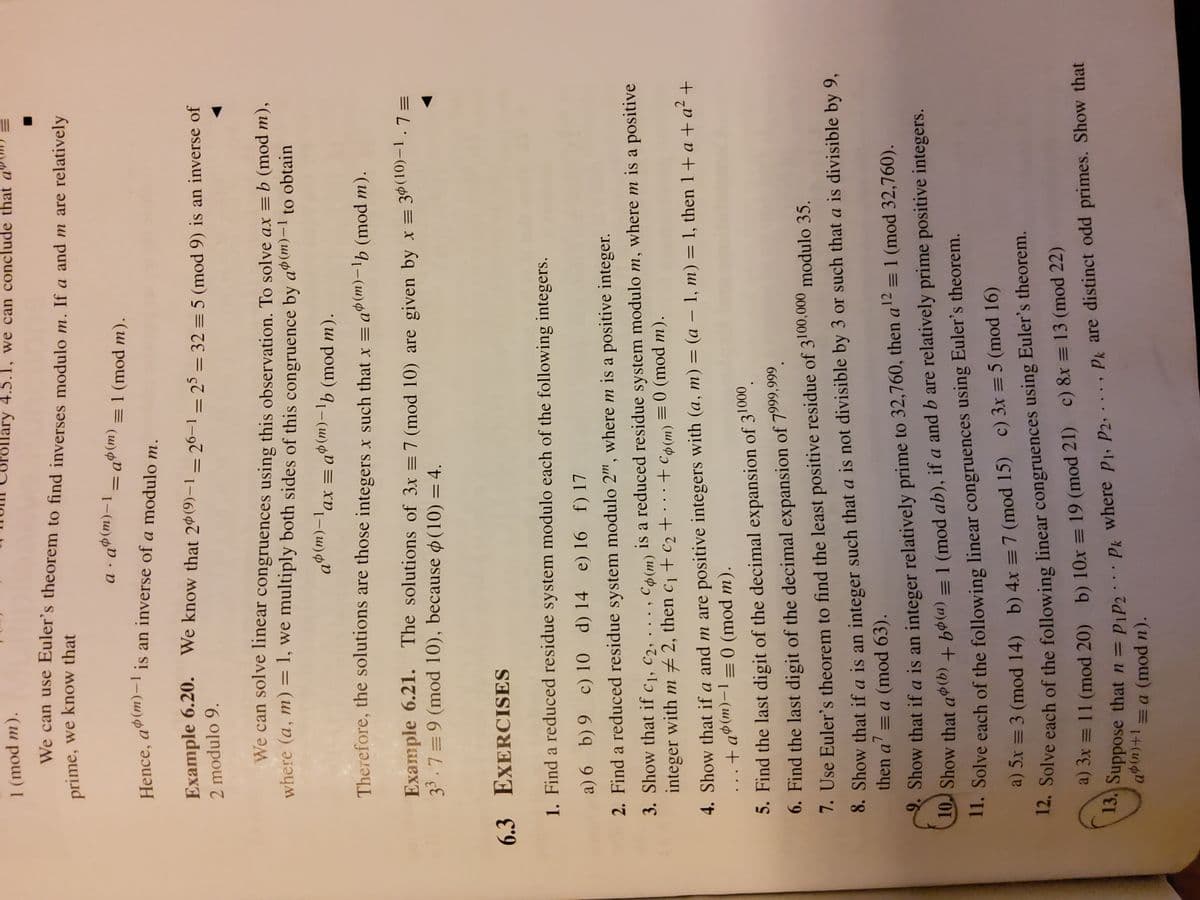Using the Euler's Theorem how can I solve 6.3 Question 1 parts a,b,c,d,e and f
Algebra & Trigonometry with Analytic Geometry
13th Edition
ISBN:9781133382119
Author:Swokowski
Publisher:Swokowski
Chapter1: Fundamental Concepts Of Algebra
Section1.2: Exponents And Radicals
Problem 90E
Related questions
Question
Using the Euler's Theorem how can I solve 6.3 Question 1 parts a,b,c,d,e and f

Transcribed Image Text:1 (mod m).
11. Solve each of theorem.
12. Solve of the linear using theorem.
llary 4.5.1, we can conclude that a"
We can use Euler's theorem to find inverses modulo m. If a and m are relatively
prime, we know that
a . q®(m)–1 - a»(m) = 1 (mod m).
Hence, a$(m)-lis an inverse of a modulo m.
(u)4D =
Example 6.20. We know that 2º(9)–1 – 26–1 – 25 = 32 = 5 (mod 9) is an inverse of
2 modulo 9.
%3D
We can solve linear congruences using this observation. To solve ax =b (mod m),
where (a, m) = 1, we multiply both sides of this congruence by aº(m)-1
to obtain
ax = a$(m)-1b (mod m).
|
|
Therefore, the solutions are those integers x such that x = aº(m)-lb (mod m).
|
Example 6.21. The solutions of 3x = 7 (mod 10) are given by x = 3%(10)-1.7=
33.7=9 (mod 10), because ø(10) = 4.
6.3 EXERCISES
1. Find a reduced residue system modulo each of the following integers.
a) 6 b) 9 c) 10 d) 14 e) 16 f) 17
2. Find a reduced residue system modulo 2", where m is a positive integer.
3. Show that if c1, c2, . . . , C6(m) is a reduced residue system modulo m, where m is a positive
integer with m # 2, then c1 + c2 +
· + Có (m) = 0 (mod m).
..
4. Show that if a and m are positive integers with (a, m) = (a – 1, m) = 1, then 1+ a + a² +
.+a®(m)-1=0 (mod m).
||
ш
5. Find the last digit of the decimal expansion of 31000.
6. Find the last digit of the decimal expansion of 7999,999,
7. Use Euler's theorem to find the least positive residue of 3100,000 modulo 35.
8. Show that if a is an integer such that a is not divisible by 3 or such that a is divisible by 9,
then a' = a (mod 63).
12
= 1 (mod 32,760).
Show that if a is an integer relatively prime to 32,760, then a'²
10J Show that a$(b) + bø(a) = 1 (mod ab), if a and b are relatively prime positive integers.
1. Solve each of the following linear congruences using Euler's theorem.
a) Sx = 3 (mod 14) b) 4x = 7 (mod 15) c) 3x = 5 (mod 16)
14. Solve each of the following linear congruences using Euler's theorem.
a) 3x = 11 (mod 20) b) 10x = 19 (mod 21) c) 8x = 13 (mod 22)
uppose that n = Pip2:.. p, where pj, P2, . . . , Pk are distinct odd primes. Show that
Expert Solution
This question has been solved!
Explore an expertly crafted, step-by-step solution for a thorough understanding of key concepts.
This is a popular solution!
Trending now
This is a popular solution!
Step by step
Solved in 4 steps with 4 images

Recommended textbooks for you

Algebra & Trigonometry with Analytic Geometry
Algebra
ISBN:
9781133382119
Author:
Swokowski
Publisher:
Cengage

Elements Of Modern Algebra
Algebra
ISBN:
9781285463230
Author:
Gilbert, Linda, Jimmie
Publisher:
Cengage Learning,

Linear Algebra: A Modern Introduction
Algebra
ISBN:
9781285463247
Author:
David Poole
Publisher:
Cengage Learning

Algebra & Trigonometry with Analytic Geometry
Algebra
ISBN:
9781133382119
Author:
Swokowski
Publisher:
Cengage

Elements Of Modern Algebra
Algebra
ISBN:
9781285463230
Author:
Gilbert, Linda, Jimmie
Publisher:
Cengage Learning,

Linear Algebra: A Modern Introduction
Algebra
ISBN:
9781285463247
Author:
David Poole
Publisher:
Cengage Learning

Elementary Geometry For College Students, 7e
Geometry
ISBN:
9781337614085
Author:
Alexander, Daniel C.; Koeberlein, Geralyn M.
Publisher:
Cengage,